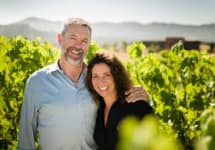Sine Qua Non The Moment 2011
-
Robert
Parker



Product Details
Your Rating
Somm Note
Winemaker Notes
Professional Ratings
-
Robert Parker's Wine Advocate
Starting off the tasting and a prodigious, unctuous white, the 2011 The Moment checks in as a blend of 57% Roussanne, 19% Petit Manseng, 17% Chardonnay and 7% Viognier that spent 16 months in a combination of concrete, new and used barrels, and stainless steel. Offering up notions of marzipan, citrus oil flowers, marmalade and spiced apricots, it flows onto the palate with full-bodied richness and depth that-s balanced by beautiful underlying freshness and clarity. While I would lean towards drinking bottles over the coming 2-3 years, these can absolutely age, and have upwards of 10-15+ years of longevity. Drink now-2017+.


Sine Qua Non has its own winemaking facility in Ventura, California not far from the Santa Barbara vineyards where the fruit is sourced from. In the last few years Manfred and his wife, Elaine, have begun creating their own vineyards dedicated to Rhone varietals. Their winemaking philosophy is to work in very small batches, gravity flow, natural yeasts (unless a fermentation problem is anticipated), long lees aging for the whites and repeated racking for the reds to open them up. This is a modified explanation of a very dedicated and artistic approach to winemaking. The wines are simultaneously very rich and elegant, superbly balanced and thoroughly harmonious with food, never overwhelming.

Full-bodied and flavorful, white Rhône blends originate from France’s Rhône Valley. Today these blends are also becoming popular in other regions. Typically some combination of Grenache Blanc, Marsanne, Roussanne and Viognier form the basis of a white Rhône blend with varying degrees of flexibility depending on the exact appellation. Somm Secret—In the Northern Rhône, blends of Marsanne and Roussanne are common but the south retains more variety. Marsanne, Roussanne as well as Bourboulenc, Clairette, Picpoul and Ugni Blanc are typical.

Responsible for the vast majority of American wine production, if California were a country, it would be the world’s fourth largest wine-producing nation. The state’s diverse terrain and microclimates allow for an incredible range of red wine styles, and unlike tradition-bound Europe, experimentation is more than welcome here. California wineries range from tiny, family-owned boutiques to massive corporations, and price and production are equally varied. Plenty of inexpensive bulk wine is made in the Central Valley area, while Napa Valley is responsible for some of the world’s most prestigious and expensive “cult” wines.
Each American Viticultural Area (AVA) and sub-AVA of has its own distinct personality, allowing California to produce red wine of every fashion: from bone dry to unctuously sweet, still to sparkling, light and fresh to rich and full-bodied. In the Napa Valley, Cabernet Sauvignon, Merlot, Chardonnay and Sauvignon Blanc dominate vineyard acreage. Sonoma County is best known for Chardonnay, Pinot Noir, Cabernet Sauvignon, Rosé and Zinfandel. The Central Coast has carved out a niche with Rhône Blends based on Grenache and Syrah, while Mendocino has found success with cool climate varieties such as Pinot noir, Riesling and Gewürztraminer. With all the diversity that California wine has to offer, any wine lover will find something to get excited about here.
